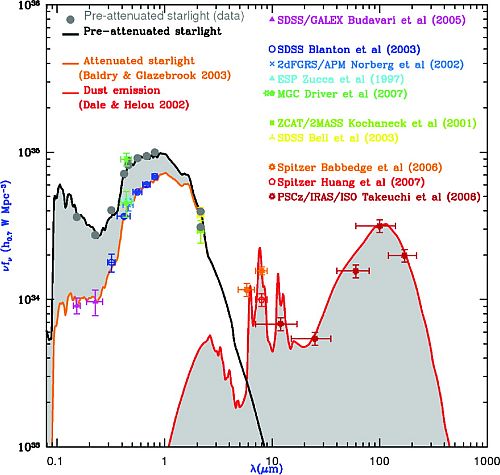Using the Millenium Galaxy Catalogue, compiled with data obtained with the Isaac Newton Telescope, astronomers have calculated that the Universe is actually twice as bright as previously thought.
In the latest
Astrophysical Journal Letters (10th May), the astronomers describe how dust is obscuring approximately half of the light that the Universe is currently generating.
While astronomers have known for some time that the Universe contains small grains of dust, they had not realised the extent to which this is restricting the amount of light that we can see.
The dust absorbs starlight and re-emits it, making it glow. They knew that existing models were flawed, because the energy output from glowing dust appeared to be greater than the total energy produced by the stars.
Dr Driver said, “You can’t get more energy out than you put in so we knew something was very wrong. Even so, the scale of the dust problem has come as a shock — it appears that galaxies generate twice as much starlight as previously thought.”
The team combined an innovative new model of the dust distribution in galaxies developed by Dr Cristina Popescu of the University of Central Lancashire and Prof Richard Tuffs of the Max Plank Institute for Nuclear Physics,
with data from the Millennium Galaxy Catalogue, a state-of-the-art high resolution catalogue of 10,000 galaxies assembled by Driver and his team using the Isaac Newton Telescope.
Using the new model, the astronomers could calculate precisely the fraction of starlight blocked by the dust. The key test that the new model passed was whether the energy of the absorbed starlight equated to that detected from the glowing dust.
“The equation balanced perfectly”, said Dr Cristina Popescu, “and for the first time we have a total understanding of the energy output of the Universe over a monumental wavelength range.”
 |
The cosmic energy output covering the region dominated by starlight (left peak) and by dust emission (right peak).
The orange line shows the observed (uncorrected) cosmic energy output from the total nearby galaxy population, while the black line shows the same after correction for the fraction of photons attenuated by dust (extrated from S.P. Driver et al., 2008, ApJ, 678, L101).
|
The Millenium Galaxy Catalogue (1998-2001) was one of the awarded science programmes of the INT Wide Field Survey, a long-term observing time allocation on the Isaac Newton Telescope with the aim of
carrying out advanced surveys of the sky to take advantage of the superb quality of INT's imaging Wide Field Camera.
More information:
- The Millenium Galaxy Catalogue web pages.
- S. P. Driver et al., 2008, "The Energy Output of the Universe from 0.1 to 1000 µm", ApJ, 678, L101.
- Astronomers find that Universe shines twice as bright, STFC press release, 15th May, 2008.
Available versions: HTML | PDF (local copy).
- "Astronomers discover full glory of the Universe",
Swinburne University of Technology Press Release, 15th May, 2008. Available versions: HTML | PDF (local copy).
- Presentado en la Asamblea de la Unión Astronómica Internacional el estudio “Millennium Galaxy Catalogue”. IAC Press Release, 30th August, 2006. Available formats: HTML.
- A Matter of Darkness. Press Release from St Andrews University, 18th August, 2006. Available formats: HTML.



